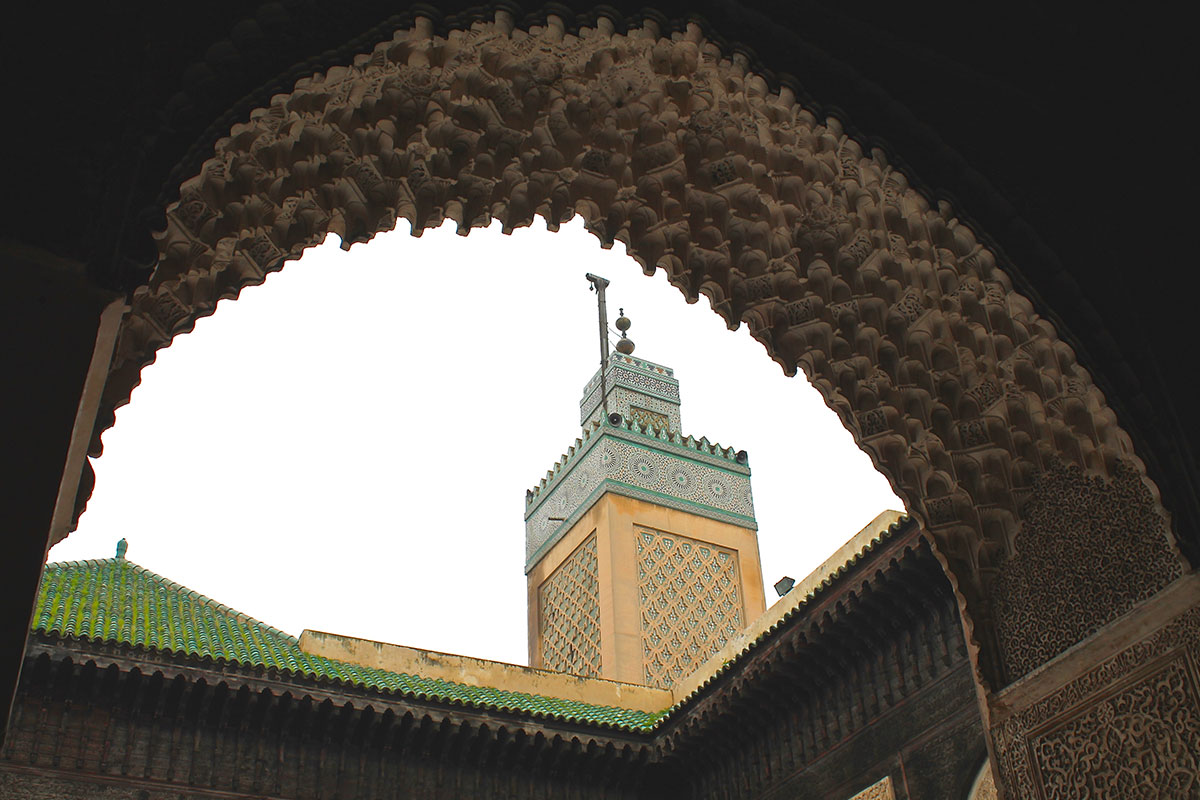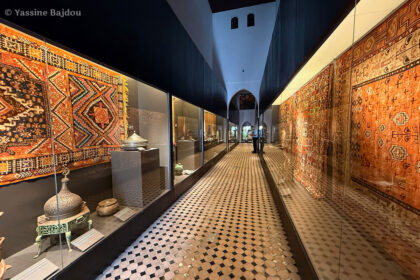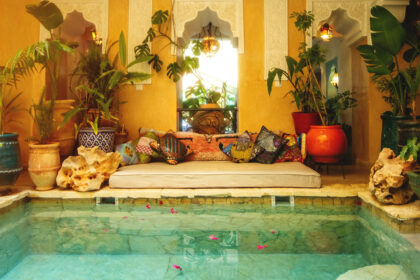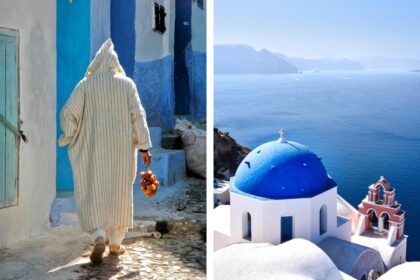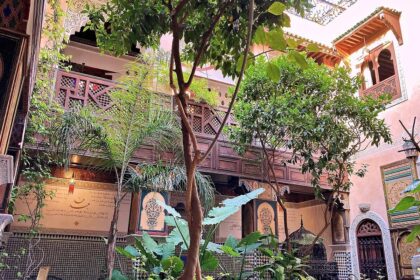Standing proudly in the heart of Fez’s ancient medina, Bou Inania Madrasa represents the pinnacle of Moroccan Islamic architecture. This 14th-century marvel isn’t just another historical monument—it’s a living testament to the artistic brilliance and cultural sophistication of the Marinid dynasty. What sets this madrasa apart from its contemporaries is its unique status as both an educational institution and a functioning mosque, complete with its own minaret.
The intricate geometric patterns adorning its walls, the whisper of fountains in its central courtyard, and the warm glow of light filtering through cedar mashrabiya screens create an atmosphere that transports visitors back seven centuries. For anyone seeking to understand Morocco’s rich Islamic heritage, Bou Inania Madrasa serves as an essential window into a golden age of artistic achievement and religious scholarship.
History of Bou Inania Madrasa
Construction and Founding
“a thing of beauty is beyond reckoning.”
The construction of Bou Inania Madrasa began in 1351 under the patronage of Sultan Abu Inan Faris, the Marinid ruler who sought to create the most magnificent educational institution in his empire. The project took four years to complete, with the sultan sparing no expense in recruiting the finest craftsmen from across North Africa and Andalusia.
The madrasa’s name derives from its royal patron—”Bou Inania” literally means “built by Abu Inan” in Arabic. Abu Inan Faris envisioned this institution as more than just a school; he wanted to create a symbol of Marinid power and Islamic piety that would rival the great madrasas of Baghdad and Cairo. The enormous cost of construction allegedly prompted the sultan to throw the project’s accounts into the river, declaring that “a thing of beauty is beyond reckoning.”
Role in Religious and Educational Life
For centuries, Bou Inania Madrasa functioned as one of Morocco’s premier centers of Islamic learning. Students from across the Maghreb and Al-Andalus came here to study Quranic sciences, Islamic jurisprudence, Arabic literature, and mathematics. The madrasa could accommodate up to 60 students in its residential quarters, each cell furnished with built-in study alcoves and storage spaces.
Unlike most madrasas, which served purely educational purposes, Bou Inania held the unique distinction of functioning as a congregational mosque. This dual role made it the only madrasa in Fez where Friday prayers could be held, a privilege typically reserved for major mosques. The institution maintained this educational role well into the 20th century, though its importance gradually diminished as modern educational systems emerged.
Changes and Restorations Through Time
The madrasa has undergone several restoration campaigns throughout its history. The most significant restoration occurred in the 20th century when Moroccan authorities recognized the urgent need to preserve this architectural treasure. Recent conservation efforts have focused on stabilizing the structure and restoring the intricate decorative elements using traditional techniques and materials.
The UNESCO recognition of Fez’s medina as a World Heritage Site in 1981 brought international attention to the madrasa’s preservation needs. Today, ongoing maintenance work continues to protect the building from the effects of time, weather, and the millions of visitors who pass through its doors each year.
Architectural Features of Bou Inania Madrasa
Overall Design and Layout
Bou Inania Madrasa follows the traditional Moroccan madrasa plan, organized around a central rectangular courtyard. However, its execution surpasses most contemporary examples in both scale and artistic refinement. The building measures approximately 34 meters long and 24 meters wide, making it one of the largest madrasas in the region.
The structure rises three stories around the central courtyard, with student cells on the upper levels and common areas below. A sophisticated system of corridors and staircases connects different sections while maintaining the privacy essential to monastic life. The inclusion of a functioning minaret—a rare feature for madrasas—adds vertical drama to the composition and underscores the building’s unique status.
Materials and Craftsmanship
The craftsmen who built Bou Inania Madrasa employed the finest materials available in the medieval world. Cedar wood from the Middle Atlas mountains was carved into intricate geometric patterns and calligraphic inscriptions. The famous zellij tilework features thousands of hand-cut geometric pieces in white, green, blue, and black—colors that held deep symbolic meaning in Moroccan art.
Carved stucco work covers vast expanses of wall surface, displaying an infinite variety of arabesque and geometric motifs. The craftsmen achieved remarkable precision in their work, with patterns that seem to flow seamlessly from one surface to another. Bronze fixtures, including door hardware and lighting elements, were crafted with equal attention to detail and artistic merit.
Key Architectural Highlights
The grand entrance portal immediately announces the madrasa’s importance. Framed by a horseshoe arch and decorated with intricate muqarnas (honeycomb) vaulting, the doorway features bronze doors adorned with geometric patterns. Visitors pass through this portal into a small vestibule before entering the magnificent central courtyard.
The courtyard itself represents the heart of the madrasa. A central fountain, fed by channels carved into white marble, provides both practical water for ablutions and aesthetic pleasure through the gentle sound of flowing water. The fountain’s octagonal shape and intricate carved decoration make it a masterpiece of Islamic decorative art.
The prayer hall, located on the qibla (Mecca-facing) side of the courtyard, features a beautiful mihrab decorated with zellij tilework and carved stucco. The minaret, rising 40 meters above the medina, displays the characteristic Almohad-influenced (Moroccan dynasty) design with its square base and decorative panels.
Symbolism in Design
Every decorative element in Bou Inania Madrasa carries symbolic meaning rooted in Islamic theology and philosophy. The geometric patterns represent the infinite nature of Allah, while calligraphic inscriptions from the Quran and religious poetry remind viewers of spiritual truths. The interplay of light and shadow created by the architectural forms symbolizes the relationship between the divine and the material world.
Plant motifs, stylized beyond recognition, hint at paradise while avoiding the representation of living creatures prohibited in religious art. The use of water, both in the central fountain and in the symbolic “rivers” created by the marble channels, references Quranic descriptions of paradise and provides practical benefits for ritual purification.
Cultural and Religious Significance
Throughout its active educational period, Bou Inania Madrasa produced generations of Islamic scholars, judges, and religious leaders who shaped Moroccan society. The curriculum emphasized traditional Islamic sciences, with particular attention to Maliki jurisprudence—the school of Islamic law predominant in Morocco.
The madrasa’s library once housed thousands of manuscripts covering subjects from theology to astronomy. Many of these texts were copied by students as part of their education, helping to preserve and transmit Islamic knowledge across generations. The institution’s reputation attracted scholars from as far away as Timbuktu and Istanbul, making it a truly international center of learning.
The dual function of Bou Inania as both educational institution and place of worship created a unique dynamic within its walls. Students could seamlessly transition from study to prayer, living in an environment where learning and worship were integrated aspects of daily life. This arrangement reflected the Islamic ideal that knowledge and piety should be inseparable.
The ability to hold Friday prayers gave the madrasa additional prestige and drew the broader Fez community into regular contact with the institution. Merchants, craftsmen, and ordinary citizens would join students and faculty for weekly congregational prayers, creating a bridge between the scholarly community and urban society.
Influence on Later Moroccan Architecture
Bou Inania Madrasa established architectural standards that influenced subsequent Islamic buildings throughout Morocco. Its refined use of traditional materials and decorative techniques became a model for later construction projects. The successful integration of educational and religious functions in a single building inspired similar projects in other Moroccan cities.
Elements pioneered or perfected at Bou Inania—such as specific geometric patterns, proportional relationships, and decorative arrangements—can be found in later mosques, palaces, and madrasas throughout the region. The building’s architectural vocabulary became part of the classical Moroccan style that continues to influence contemporary architecture.
How it Reflects Marinid Dynasty’s Power and Ideals
The construction of Bou Inania Madrasa represented a massive investment of resources that demonstrated Marinid wealth and sophistication. By creating such a magnificent educational institution, Abu Inan Faris positioned his dynasty as patrons of learning and defenders of Islamic orthodoxy. The madrasa’s grandeur was intended to impress both subjects and foreign dignitaries with the dynasty’s cultural achievements.
The emphasis on traditional Islamic education and orthodox religious practice reflected Marinid efforts to legitimize their rule through piety and learning. By supporting religious scholarship, the dynasty strengthened ties with the ulema (religious scholars) whose support was essential for political stability.
Visiting Bou Inania Madrasa Today
Location and Accessibility in Fez
Bou Inania Madrasa is located on Talaa Kebira, one of the main thoroughfares through Fez’s medina, making it easily accessible to visitors. The madrasa sits near several other important monuments, including the Bou Jeloud Gate and the Dar Batha Museum. Its central location makes it an ideal starting point for exploring the historic medina.
What to Expect During a Visit
A typical visit to Bou Inania Madrasa takes 30 minutes to an hour, though architecture enthusiasts may wish to spend longer admiring the decorative details. Visitors enter through the grand portal and proceed to the central courtyard, where the full architectural magnificence becomes apparent.
The contrast between the busy medina streets and the peaceful courtyard creates an immediate sense of sanctuary and contemplation. Sunlight filtering through the open courtyard illuminates the intricate decorative work, creating an ever-changing play of light and shadow throughout the day.
Key highlights not to miss include the central fountain with its geometric patterns, the prayer hall mihrab, the student cells with their study alcoves, and the views of the minaret from the courtyard. Information plaques in multiple languages provide historical context and architectural details.
Tips for Visitors
Photography is permitted in most areas of the madrasa. Visitors should dress modestly, covering shoulders and legs, as befits a religious site. Comfortable walking shoes are essential for navigating the uneven surfaces and stairs.
The best time to visit is early morning when lighting conditions are optimal and crowds are smaller. Late afternoon also offers beautiful lighting effects as the sun angles through the courtyard. Visitors should allow extra time for getting lost in the medina—it’s part of the authentic Fez experience!
Nearby Attractions in Fez to Explore
Bou Inania Madrasa’s central location makes it an excellent starting point for exploring other medina attractions. The nearby Attarine Madrasa offers interesting architectural comparisons, while the Kairaouine Mosque and University—one of the world’s oldest continuously operating educational institutions—lies just a short walk away.
The colorful tanneries of Fez, where leather has been processed using traditional methods for centuries, are within easy walking distance. The Dar Batha Museum houses an excellent collection of traditional Moroccan arts and crafts, providing context for the decorative techniques seen in the madrasa.
Preservation and Challenges
Despite its age, Bou Inania Madrasa remains in remarkably good condition thanks to ongoing conservation efforts. The basic structure is sound, and most of the original decorative elements survive intact. However, the building faces constant challenges from weathering, pollution, and the wear caused by thousands of daily visitors.
Recent assessments have identified areas requiring urgent attention, particularly in the upper levels where student cells show signs of structural stress. The delicate zellij tilework requires constant maintenance, as individual tiles can become loose or damaged over time.
Efforts by Moroccan Authorities and UNESCO
The Moroccan government, with support from UNESCO and international partners, has implemented comprehensive conservation programs for the medina’s historic monuments, including Bou Inania Madrasa. These efforts emphasize using traditional materials and techniques to maintain the building’s authenticity.
Specialized craftsmen trained in traditional techniques carry out restoration work under the supervision of conservation experts. This approach ensures that repairs match the original construction methods and materials, preserving the building’s historical integrity for future generations.
Threats from Urban Development and Tourism
The success of Fez as a tourist destination has created new challenges for monument preservation. Increased foot traffic puts stress on delicate architectural elements, while nearby development projects can affect the structural stability of historic buildings.
Managing visitor numbers while maintaining public access requires careful balancing. The installation of protective barriers around the most fragile decorative elements helps reduce damage while still allowing visitors to appreciate the madrasa’s beauty.
| Aspect | Details |
|---|---|
| Built | 1351-1355 CE |
| Founder | Sultan Abu Inan Faris |
| Architecture Style | Moroccan Marinid Architecture |
| Unique Features | Only madrasa in Fez with minaret and Friday prayers |
| Key Materials | Cedar wood, zellij tiles, carved stucco, marble |
| Current Status | UNESCO World Heritage Site (part of Fez medina) |
| Visiting Hours | 9:00 AM – 6:00 PM (varies seasonally) |
| Admission | ~20 MAD for adults |
| Photography | Permitted |
| Notable Features | Central fountain, prayer hall, minaret, student cells |
Bou Inania Madrasa stands as an enduring monument to the artistic achievements and cultural sophistication of medieval Morocco. This architectural masterpiece continues to captivate visitors with its harmonious proportions, exquisite craftsmanship, and spiritual atmosphere. The building’s unique dual role as educational institution and place of worship reflects the Islamic ideal of integrating learning with faith, while its decorative program represents the pinnacle of Moroccan Islamic art.
As we face an increasingly connected yet fragmented world, places like Bou Inania Madrasa remind us of the importance of preserving our shared cultural heritage. By visiting this remarkable monument and supporting conservation efforts, we help ensure that future generations can experience the wonder and wisdom embodied in its ancient walls. The madrasa’s story—of royal patronage, scholarly achievement, and artistic excellence—continues to inspire and educate, making it truly deserving of its reputation as the crown jewel of Marinid architecture.








